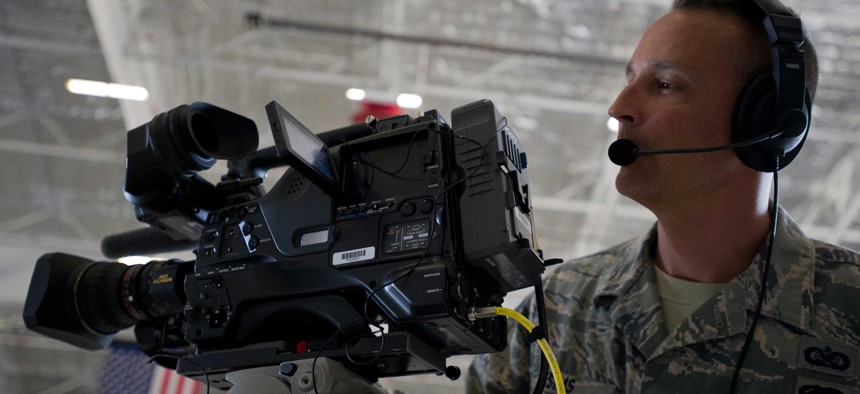
An Air Force NCO rehearses as part of the preparation for the Chief of Staff of the Air Force transition ceremony. 11th Wing Public Affairs by Senior Airman Perry Aston
Pentagon Channel Goes Off the Air
Programming to move online or to the Armed Forces Network.
The U.S. military’s internal television network once known for “The Grill Sergeant,” “Fit for Duty” and the euphemistically named “FNG” will soon be no more. The Defense Department will stop broadcasting the Pentagon Channel this week after concluding that it needed a more cost-efficient and relevant way of delivering news and entertainment programming just for service members and their families.
The Pentagon announced Tuesday that as of April 17 the network once known as the Pentagon Channel and now known as “DoD News” will discontinue service as an independent channel, but will continue to produce and air “current military news and information” on another military network known as the Armed Forces Network, and on the Internet.
Pentagon spokesman Col. Steve Warren said the decision was made for a few different reasons. “We’re operating in a time of constrained resources and this is one of the tough decisions we’ve had to make, to eliminate the broadcast component of ‘DoD News,’” Warren told Defense One. Programming will air on the Defense Department’s Armed Forces Network for service members overseas or on the Internet. “We think the future is in online anyways,” he said.
Indeed, the technology had changed the thinking of what could be done, according to a Pentagon statement.
“The transition to these delivery methods will provide more opportunities for the military community, stationed around the world and at sea, to keep up with DoD news and events,” defense officials said in the statement. “As technology improved and audience-viewing habits changed, Internet based distribution became a more economical and efficient way to reach the military's geographically dispersed audiences.”
Although there is a need to be able to reach service members and their families, the Pentagon has struggled to keep its television network relevant and useful as technology and viewership changed.
The wars in Iraq and Afghanistan – not to mention the regular deployment of tens of thousands of forces around the world – made it difficult to broadcast programming in the normal, linear fashion to troops in diverse time zones. And after studying the issue at some length, the Pentagon found it could be cheaper to move to a new approach.
The Pentagon Channel is different from the Armed Forces Network, or AFN, which is the typical way troops stationed overseas watch Defense Department programming, mainstream cable news and sports shows. The Pentagon Channel was conceived as a way to supply other kinds of lifestyle-oriented news and information to service members. But as the audience began to want more on-demand information, the Channel’s viewership dwindled.
The Defense Department is expected to save money on the deal, too. According to defense officials in 2013, the Pentagon Channel costs about $5 million per year.
